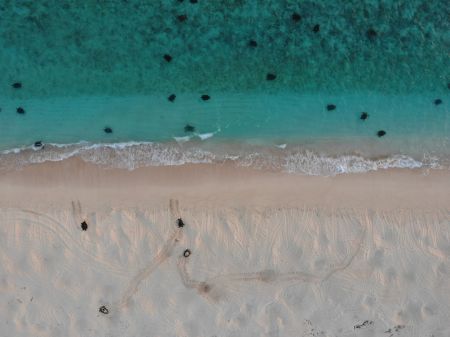Protecting the world's largest green turtle rookery on Raine Island


On a small, remote coral cay on the northern edge of the Great Barrier Reef, a spectacular occurrence happens each summer when tens of thousands of green turtles visit Raine Island, the world’s largest green turtle rookery.
Raine Island is a significant and cultural story place for the Traditional Owners—the Wuthathi People from Cape York and the Meriam Nation (Ugar, Mer, and Erub) People from the eastern Torres Strait. They have been visiting Raine Island for thousands of years.
The entire island is a protected national park (for scientific purposes) and is not accessible to the public. Senior Project Officer for the Raine Island Recovery Project Katharine Robertson said scientists have studied the green turtles here since 1974, gradually gathering data about the threatened species.


“Since the mid-1990s, researchers have been alarmed to see low hatchling numbers,” Katharine said. “When I first visited the island, I was in awe of the turtles, but also heartbroken seeing the countless newly laid eggs that had died after the tidal waters flooded much of the nesting beach.”
The Raine Island Recovery Project began in 2014. During the first project phase, a collaborative team of government, industry, and Wuthathi and Meriam Nation Traditional Owners worked to reduce the inundation threat.
In 2014, 2014, 2017 and 2019, the team worked to reprofile the beach, shifting 40,000m3 of sand, raising it above the risk zone, doubling the viable nesting habitat on the island and increasing hatching success.
The team has also installed cliff-top fencing around the island to prevent turtles from falling on their backs and becoming unable to right themselves.
“During each field trip, we walk the island every morning, helping turtles trapped in the rocks or under the cliff edges,” Katharine said.
“We carry exhausted or disorientated turtles back to the water’s edge on a turtle sled or the power carrier. If we don’t rescue these turtles, they may overheat and die on the beach. We’ve saved over 700 adult green turtles, which are important to this population.”
Another grave threat to the green turtle population is rising temperatures.


“Higher sand temperatures produce female hatchlings,” Katharine explained.
“Almost all the hatchlings from Raine Island are female. Long-term, we may not have enough males to sustain this population. Addressing this is our next biggest challenge!”
The team continues to monitor green turtle activity on the island and conduct research to increase the species’ resilience.


